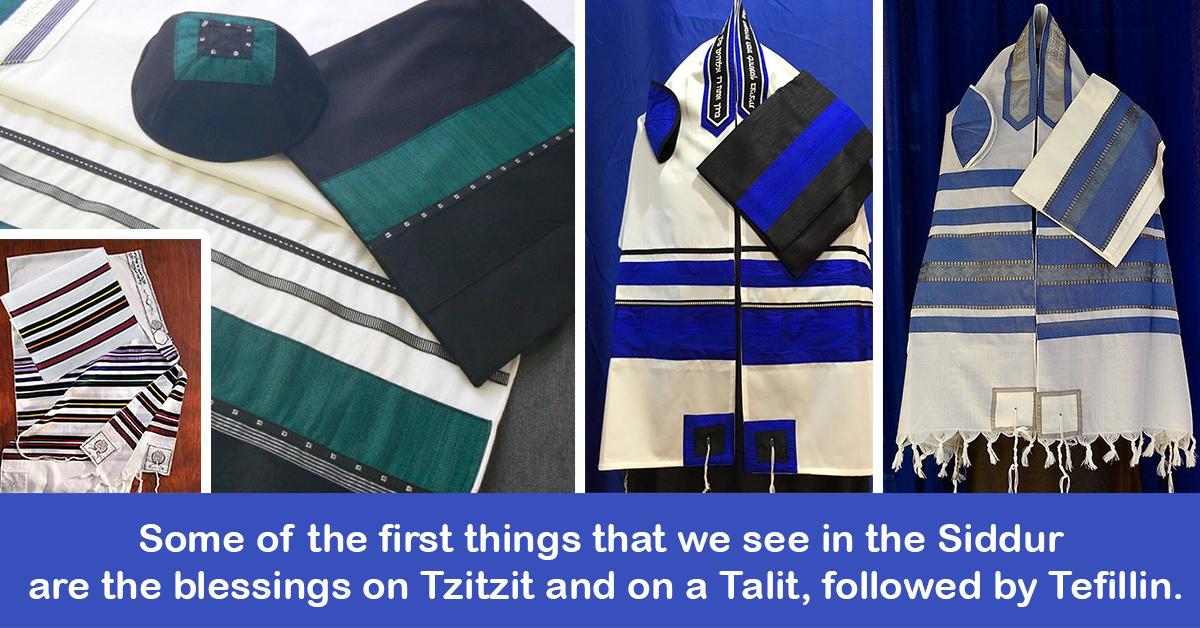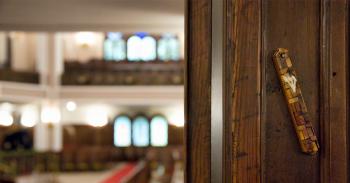
Some of the first things that we see in the Siddur are the blessings on Tzitzit and on a Talit, followed by Tefillin. We bless over a Talit before we bless over Tefillin. This is because we have to wear Tzitzit all the time, to remind us to keep Mitzvot, whereas the main reason that we wear Tefillin is for Kriat Shema and prayers, to accept the Yoke of Heaven. The general Mitzvah precedes the specific.
The Shulchan Aruch gives another reason for this, i.e. that we go from a lower holiness to a higher one - Tefillin. In the Beit Yosef he gives yet another reason, that whatever is done more regularly takes precedence. Since we don’t lay Tefillin every day but do wear Tzitzit and a Talit every day, then the latter take precedence. In addition to all this, the Siddur Otsar Hatephilot notes that the Mitzvah of Tzitzit is equivalent to all the other Mitzvot, as opposed to Tefillin. Therefore, the former takes precedence.
We derive the Mitzvah of Tzitzit from the verses in Numbers 16:38-40, that we say together with the Shema:
Speak to the Children of Israel and tell them that they should make themselves Tzitzit on the corners of their garments for generations, and they should place a thread of turquoise wool on the Tzitzit of each corner. And it should constitute Tzitzit for you, and you will see it and remember all the Commandments of the Lord and you will perform them and not wander after your hearts and eyes that you stray with. So that you will remember and perform all My commandments, and you will be holy to your G-d.
There are several reasons why we wear Tzitzit.
We make one Blessing on Tzitzit, and a different one on a Talit, and it is interesting to see why they are different, and how they should be made.
Ashkenazim are accustomed to make a Blessing, ,על מצות ציצית over Tzitzit that we wear after washing our hands, when we get up. When we put a Talit on, however, we make a different Blessing, להתעטף בציצית.
The Darkei Moshe explains why Ashkenazim make two different blessings over Tzitzit and a Talit, and this is because we take authorities who rule that we can’t fulfil our obligation with a Talit Katan into account. Therefore, we are unable to bless להתעטף בציצית over a Talit Katan. Another reason not to bless להתעטף בציצית over a Talit Katan is because that would imply that we are fulfilling our obligation at this moment. We do bless על מצות ציצית, however, to thank Hashem for giving us the Mitzvah of Tzitzit, even though we have not fulfilled it yet.
The Siddur Otsar Hatephilot writes that we should put our Talit and Tefillin on before we leave the house in the morning. That way, we come out in an honorable and enhanced manner, making an impression Above, as the Zohar points out several times. Otherwise, going into a synagogue without wearing Talit and Tefillin, and saying, אשתחוה אל היכל קדשיך ביראתיך (I will bow down to You, Hakadosh Baruch Hu, where you have laid your Holiness, in Your Honor) would be contradictory, as He asks, “Where is My honor?” If we are outside Israel, though, unless we are in a Jewish street, it might not be feasible to go out like that. In that case, we should put our Talit and Tefillin on in the synagogue corridor.
We should also check our Tzitzit before we put them on, especially the loops at the top, where they go through the Talit. (A Talit would be invalid if a loop is broken).
There is a specific way to put a Talit on, as we have to wrap it around us. As we wrap the Talit around us, we have to keep in mind that Hakadosh Baruch Hu has commanded us to wrap ourselves this way to remember all his Mitzvot, so that we can keep them, as the Beit Yosef tells us. Without having this in mind, we might not be fulfilling our obligation, according to the Eliyahu Rabbah. After blessing, we should put the Talit over our heads, lengthwise. We then fling the two right-hand fringes over our left shoulder, leaving the left-hand ones alone. We should leave the Talit this way for the time that it takes to walk four cubits, about 10 seconds. We can then take the right-hand fringes away and arrange the Talit so that we can cover our heads at will, with all four Tzitzit facing us. We then move one right-hand fringe behind us on our right, and a left-hand fringe likewise, and fold each side over each shoulder. We should then be surrounded by Tzitzit on all sides. Ideally, a Talit should be large enough to wrap it round us comfortably, although some people prefer a smaller Talit.
The Smak rules that this should all be done standing up. This is derived from a comparison with counting the Omer, where the Torah tells us that we should count for ourselves. With Tzitzit it says, “And it should constitute Tzitzit for you”. Just as it says “That you should count seven weeks from the time the sickle is first put to the standing corn- Bekomah, i.e. “Bekomah”, standing, which means that we also have to stand when we bless over Tzitzit.



